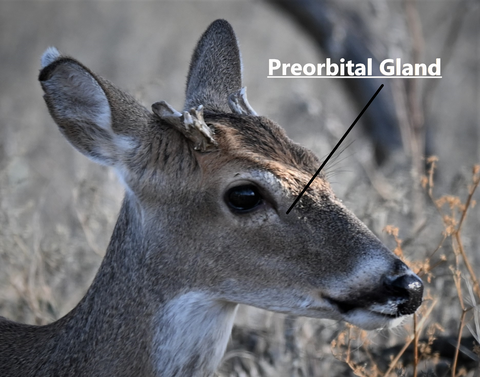
Learn to speak “Deer Language” Part 1 Preorbital Glands
Understanding Deer Language and Preorbital Glands
Written By: Brandon Houston
It's relatively simple when you get right down to it! Unfortunately, most hunters do not know anything about how deer communicate. This can be from a lack of knowledge or falling victim to the urine-based attractant companies' marketing for the hunting industry.
Let me be VERY clear! I’m not saying urine isn’t used as a means of communication, but urine cannot be bottled, put on a shelf, and used as a communication tool. The moment urine is exposed to light and oxygen; the pheromones are almost destroyed entirely! Let that sink in a bit… The truth is that white-tailed deer have seven glands; that’s how they communicate (their actual “language”). I fully intend to explain them all in detail but to keep this “short & sweet,” I’m going to take it one at a time.
 The Preorbital Gland is located in the small slit, just past the eye's tear duct. This gland produces a secretion containing pheromones and semiochemical compounds frequently deposited on twigs. In layman’s terms… when you find a scrape, you find a “licking branch” this is where a whitetail uses this gland. As they rub the small limbs across their face, the preorbital gland leaves behind a secretion that identifies them and relays their status to other deer.
The Preorbital Gland is located in the small slit, just past the eye's tear duct. This gland produces a secretion containing pheromones and semiochemical compounds frequently deposited on twigs. In layman’s terms… when you find a scrape, you find a “licking branch” this is where a whitetail uses this gland. As they rub the small limbs across their face, the preorbital gland leaves behind a secretion that identifies them and relays their status to other deer.
Knowing this, as a hunter, should get your wheels spinning! Understanding these glands, what they are saying, and how to appropriately respond is a game changer! TRHP Outdoors is the only company that allows you to respond with pure glands and speak “Deer Language.” Deer communicate year-round. I utilize Preorbital Spray on licking branches constantly all year. If you want to keep deer on your property, this is an excellent option in your management plan.
When we talk about Deer Language, we enter a world of fascinating communication methods that deer use among themselves. One such method involves their preorbital glands. But what exactly are these glands, and how do they facilitate communication? Let's dive in to uncover the secrets of this intriguing aspect of deer behavior, and in the process, you'll learn a whole new language that's as ancient as nature itself.
The preorbital glands are small openings located in front of a deer's eyes. These glands produce pheromones that are highly instrumental in the way deer communicate with one another. When a deer rubs its face against trees, bushes, or even the ground, it leaves behind these chemical messages for other deer. This form of communication is vital, particularly during the breeding season, as it helps in establishing territory and signaling mating interests. By understanding how these glands work, you’re beginning to grasp the basics of Deer Language.
Let's examine some specific behaviors. For instance, during the rut, you'll often notice bucks rubbing their heads vigorously against various surfaces. This action is not random; it’s a deliberate way to spread their pheromones around their territory. These chemical signals can convey a range of messages—from dominant status and readiness to mate, to marking the boundaries of their range. Does, on the other hand, can detect these signals and decide which buck is the most suitable mate. So, what may seem like simple animal behavior is actually a sophisticated form of communication.
Moreover, understanding Deer Language through preorbital gland activity can help in wildlife management and conservation efforts. By monitoring these behaviors, researchers can gather valuable data on deer populations, their health, and their social structures. For hunters, this knowledge can prove incredibly useful, not only in tracking deer but also in understanding their behavior patterns without disrupting their natural way of life.
In conclusion, learning to speak the Deer Language by studying their use of preorbital glands offers a unique glimpse into the world of these majestic creatures. It’s a blend of chemistry, biology, and behavioral science that unfolds in the wild every day. Whether you're a wildlife enthusiast, a hunter, or just someone with a keen interest in animal behavior, delving into Deer Language is a fascinating journey well worth taking.
